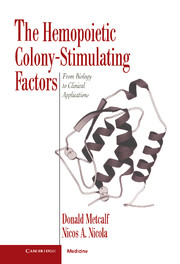Book contents
- Frontmatter
- Contents
- Preface
- 1 Historical introduction
- 2 General introduction to hemopoiesis
- 3 Key techniques in analyzing hemopoiesis
- 4 Biochemistry of the colony-stimulating factors
- 5 Biochemistry of the colony-stimulating factor receptors
- 6 Molecular genetics of the colony-stimulating factors and their receptors
- 7 Biological actions of the colony-stimulating factors in vitro
- 8 The biology of colony-stimulating factor production, degradation, and clearance
- 9 Actions of the colony-stimulating factors in vivo
- 10 Role of the colony-stimulating factors in basal hemopoiesis
- 11 Actions of the colony-stimulating factors in resistance to infections
- 12 Role of the colony-stimulating factors in other disease states
- 13 The colony-stimulating factors and myeloid leukemia
- 14 Clinical uses of the colony-stimulating factors
- 15 Conclusions
- References
- Index
2 - General introduction to hemopoiesis
Published online by Cambridge University Press: 04 August 2010
- Frontmatter
- Contents
- Preface
- 1 Historical introduction
- 2 General introduction to hemopoiesis
- 3 Key techniques in analyzing hemopoiesis
- 4 Biochemistry of the colony-stimulating factors
- 5 Biochemistry of the colony-stimulating factor receptors
- 6 Molecular genetics of the colony-stimulating factors and their receptors
- 7 Biological actions of the colony-stimulating factors in vitro
- 8 The biology of colony-stimulating factor production, degradation, and clearance
- 9 Actions of the colony-stimulating factors in vivo
- 10 Role of the colony-stimulating factors in basal hemopoiesis
- 11 Actions of the colony-stimulating factors in resistance to infections
- 12 Role of the colony-stimulating factors in other disease states
- 13 The colony-stimulating factors and myeloid leukemia
- 14 Clinical uses of the colony-stimulating factors
- 15 Conclusions
- References
- Index
Summary
To appreciate more clearly the roles played by the colony-stimulating factors in hemopoiesis, it is necessary to outline some aspects of the origin and organization of hemopoietic populations, the major cellular events occuring during hemopoiesis, and the general methods by which these events are regulated.
The first hemopoietic cells arise from nonhemopoietic precursors as a transient finite event in the blood islands of the yolk sac (Metcalf and Moore, 1971). Many of these cells then migrate to the fetal liver, where they build up to a large population (Figure 2.1) (Moore and Metcalf, 1970; Metcalf and Moore, 1971). The major recognizable cells in such populations are embryonic erythroid cells and macrophages, although populations of stem cells and progenitor cells are also present. At least in chickens, and presumably also in mammals, this yolk sac-derived hemopoietic population becomes replaced by a second population of hemopoietic cells arising de novo from nonhemopoietic precursors in the para-aortic region of the fetus (Dieterlen-Lievre and Martin, 1981). These fetus-derived hemopoietic populations replace the existing yolk sac-derived cells in the liver and then populate the developing spleen and bone marrow.
It is believed that no further de novo formation of hemopoietic cells occurs. As a consequence, throughout subsequent adult life, the hemopoietic populations are required to be self-sustaining as well as to generate continuously the large number of maturing cells in the eight major hemopoietic lineages that are needed to replace the relatively short-lived cells in the peripheral blood.
- Type
- Chapter
- Information
- The Hemopoietic Colony-stimulating FactorsFrom Biology to Clinical Applications, pp. 10 - 32Publisher: Cambridge University PressPrint publication year: 1995
- 1
- Cited by



